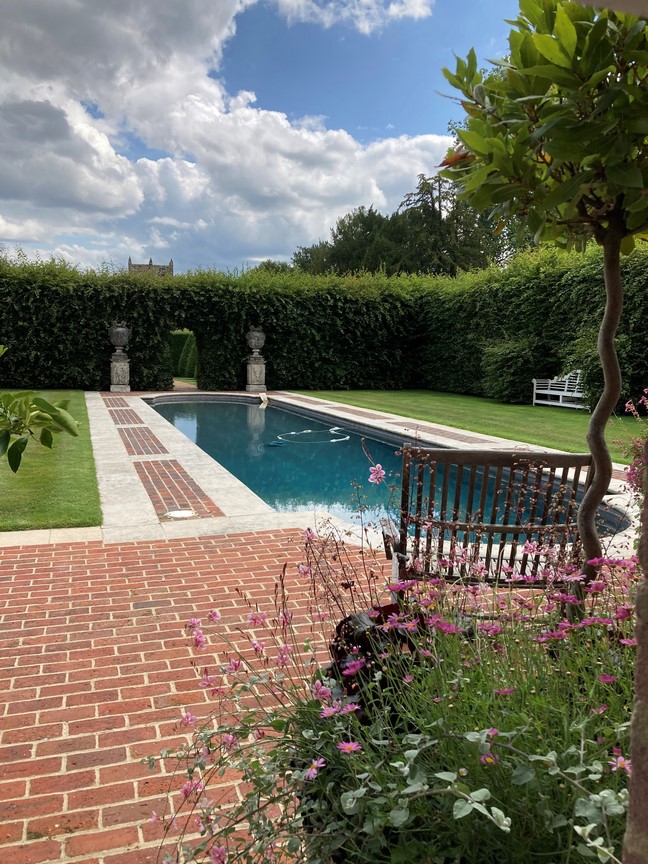Woolbeding Gardens Tour
Thursday 20 July 2023
A sizeable group of members navigated the train strikes on a fine sunny morning, to gather at the Royal Oak pub in Lavington, near Midhurst, West Sussex. From there, under the good organisation of Briony Marriott, we were taken by bus to nearby Woolbeding House.
Given to the National Trust in 1957 by the Lascelles family, from 1972 Woolbeding was leased to Simon Sainsbury and, following Simon’s death, to his partner Stewart Grimshaw.
Together they had restored the 17th century house and redesigned the gardens with the help of Lanning Roper and Julian and Isabel Bannerman.
There are colour-themed long herbaceous borders – particularly lovely just now with the cool mixture of blues, lilac and pale greys. Garden rooms divided by high yew hedges and ornamental brick pergolas. Classical style fountains and the modern William Pye mushroom water feature making a huge statement in front of the pillared elevation of the house.
Further afield, following the banks of the River Rother we come to where the Bannermans have created a woodland Pleasure Garden with a Japanese bridge, architectural follies, a stumpery and waterfalls. The whole area enclosed by huge and remarkable trees.
In 2020, Stewart Grimshaw decided on a new experimental garden called the Silk Route Garden. James, the lead gardener for this area, introduced us to the garden. With the help of Fergus Garrett – the head gardener at Great Dixter – an exciting garden had been conceived. The winding path of the design showcases plants from 12 different regions of the ancient trading route from Mediterranean Turkey, via the Black Sea coast to Teheran, the subalpine Himalayas, Kazakhstani, Tibet, and China. Plants are set among rocks and stones, exposed to all weather conditions. Trees include old olives, mulberry and Persian ironwood (Parottia); further along are acers, Chinese walnut and Himalayan birch.
Certain plants are repeated along the entire route; Giant scabious, giant fennel, hellebores, verbascums, cistus, evergreen spurges, oregano and alliums. Many of the plants have their flowering time in spring, and so are dormant in summer. To that end we did not see all the plants in flower, simply their structures among the slate outcrops, the sandy scree and granite.
At the far end of the Silk Route path, making a huge statement in the meadow, stands the Woolbeding ‘kinetic’ Glasshouse, designed by Heatherwick Studio. It is a remarkable structure that is technically as well as aesthetically unique. Filled with a mixture of subtropical plants and tender ferns, the ten upper sections, or ‘sepals’ of the structure are opened by large hydraulic machines to maintain the correct climate for the planting inside.
Fortunately, we had plenty of time to wander all over the gardens, and to enjoy a hot drink and fresh cake in the café. The formal garden rooms and ornamental vegetable potager were full of interest. An espalier of apples, beautifully trained in diamond patterns up a high wall, or low down forming a mini hedge around vegetable beds; deep crimson clematis climbing through red roses up and over the brick pergolas; a traditional wooden greenhouse full of tender architectural plants; a delightfully designed formal herb garden; and a beautiful orangery designed by Philip Jebb with a classically shaped swimming pool.
Add to all this, All Hallows Church, a Gothic summerhouse, a tulip-shaped folly, a hermit’s hut, a river god, and a ruined abbey. These structures and stone statues are dotted around the estate and delight the eye as you come upon them when exploring the further reaches of the gardens.
Finally, we gathered to return to the pub in Lavington where we had lunch and time to share our experiences, before heading for home. It had been a fascinating and stimulating visit. Thanks are due to Briony for her skill in organising the outing.
Text: Merula Frankel
Images: Melvyn Jope
















